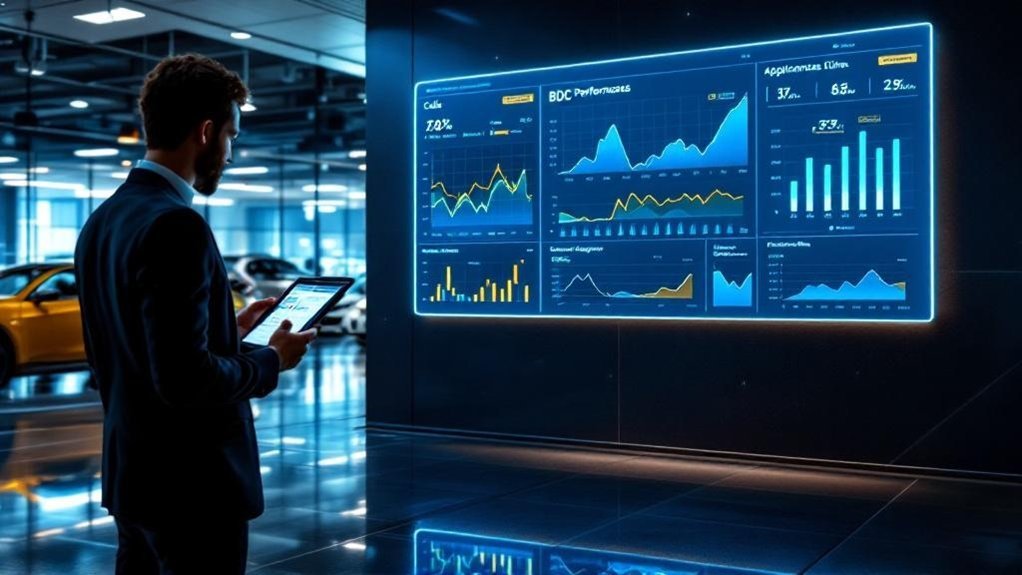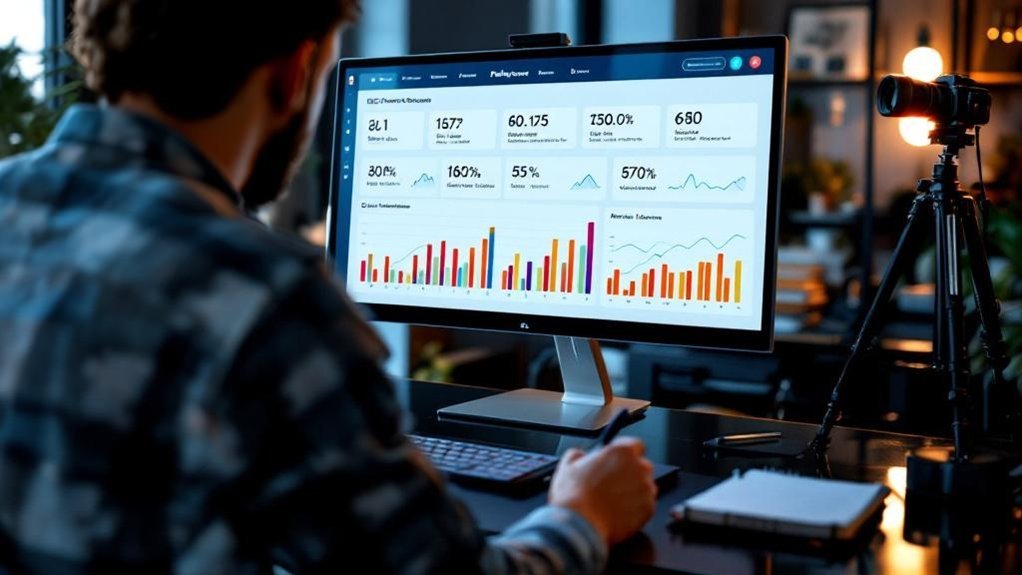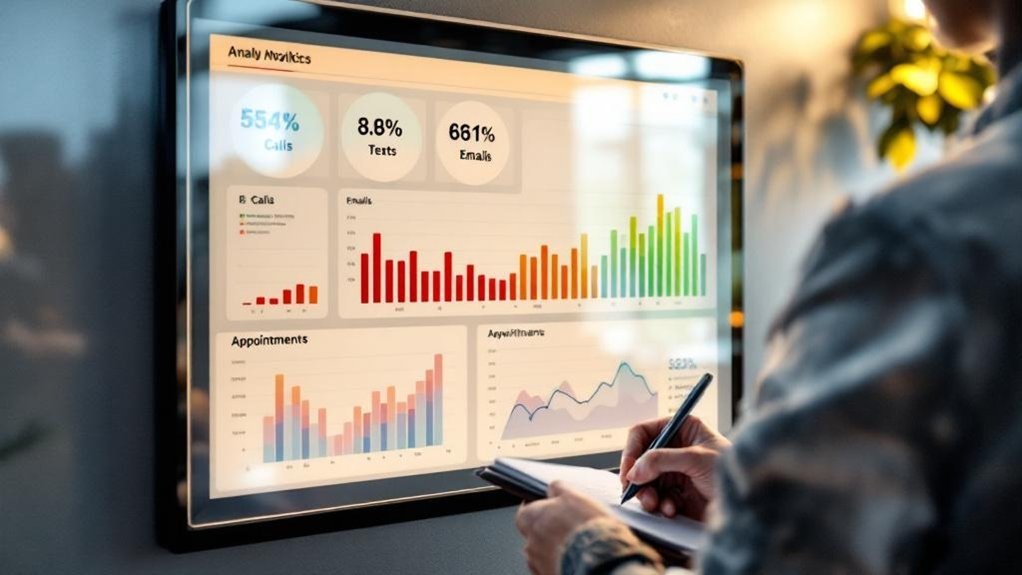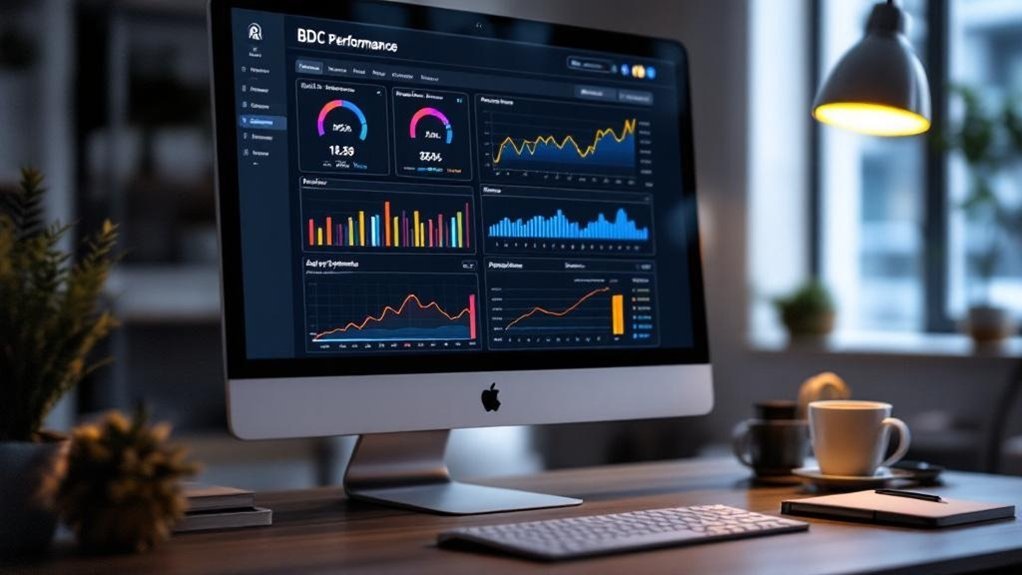You need a real-time BDC performance dashboard that tracks calls, texts, emails and appointments so you can spot slow responses, prioritize hot leads, and boost conversions. Track contact rates, inbound/outbound activity, appointment-book and show rates, and revenue-per-appointment by source. Give agents live visibility and leaderboards to drive accountability and faster follow-up. Use alerts and cross-channel signals to surface coaching opportunities and high-value leads. Keep going to see setup, integrations, and ROI measurement tactics.
Key Takeaways
- Display real-time call, text, and email activity with agent-level counts and response times to spot gaps immediately.
- Track contact, appointment-booking, and appointment-show rates per channel to identify underperforming outreach.
- Tie appointments to revenue per appointment (RPA) and units sold to quantify BDC ROI by source.
- Surface automated alerts and leaderboards for slow responses, low conversion, and coaching opportunities.
- Provide source-level conversion and RPA comparisons (web, phone, email) to prioritize high-value channels.
Why Real-Time BDC Dashboards Matter for Dealerships

Because every missed or slow response can cost revenue, real-time BDC dashboards give you immediate visibility into KPIs like call volume, text engagement, and appointment setting so you can make instant, data-driven adjustments. You’ll use BDC tracking and real-time data to spot urgent leads, reduce response gaps, and prevent lost sales opportunities. The dashboards feed CRM-integrated BDC performance metrics that remove guesswork, so your coaching and resource allocation are evidence-based and timely. Visual displays on large screens drive daily competition, spotlight top performers, and raise team velocity. With live tracking of calls, texts, and emails you’ll prioritize outreach, correct weak behaviors on the spot, and measure the impact of tactical changes immediately—delivering measurable lift in conversion and appointment rates.
Key KPIs to Track: Calls, Texts, Emails and Appointments
A tight set of KPIs—calls, texts, emails and appointments—gives you the real-time signals needed to optimize BDC performance and drive more sales. Track inbound appointment conversion rate to see what percentage of inbound calls become booked appointments; low conversion flags lost warm leads and gaps in lead management. Monitor outbound activity—calls, texts, emails—and aim to contact leads within the first hour for highest response. Measure contact rate to expose operational inefficiencies and adjust timing or method. Use appointment show rates to evaluate reminder systems and customer engagement; falling show rates require targeted interventions. Finally, tie BDC activity to total units sold so you can quantify revenue impact and prioritize the KPIs that most move the needle.
How Agent-Level Visibility Boosts Performance

Tracking calls, texts, emails and appointments gives you the signals; agent-level visibility turns those signals into action. You see real-time activity—call volume, text interactions, email responses—and can spot underperforming BDC staff instantly. When agents access their own performance metrics like response time and appointment conversion, accountability rises and agent productivity improves measurably. Dashboards present KPIs visually, so goals are clear and daily targets become tangible. Public-facing leaderboards foster healthy competition, boosting engagement and adherence to standards. Managers use continuous insight to target coaching, delivering personalized training tied to specific metric gaps. The result: faster remediation, higher conversion rates, and a performance culture where data drives focused, repeatable improvements across the BDC team.
Turning Lead Activity Into Actionable Insights
When you tie real-time call, text and email activity to visual dashboards and alerts, you turn raw signals into prioritized actions that stop leads slipping away. You’ll use BDC performance metrics to flag slow responses, low appointment conversion, and multi-channel drop-offs so interventions are timely and targeted. Automated alerts route coaching opportunities and support, reducing missed follow-ups. Cross-channel lead activity analysis exposes funnel break points and informs outreach adjustments. Integrating QA and training data refines agent scripts, improving customer engagement and retention. Below, a concise snapshot links metric, trigger, and outcome to make decisions faster.
| Metric | Trigger | Outcome |
|---|---|---|
| Response Time | >15 min | Escalate lead |
| Conversion Rate | <20% | Coach agent |
| Channel Drop-off | High SMS exits | Adjust outreach |
Designing Effective Leaderboards for Motivation

Linking real-time lead activity to actionable alerts sets the stage for leaderboards that drive daily behaviors: show the metrics that matter—call volume, appointment set and show rates, conversion ratios—and update them live so agents see the impact of their actions. You’ll design leaderboards that prioritize BDC performance metrics most tied to revenue, displaying call activity, outbound attempts, appointment show and conversion rates. Use visual dashboards with clear indicators (progress bars, color bands, badges) so reps track goal proximity and correct course instantly. Update standings dynamically to spotlight top performers for immediate recognition and to surface coaching opportunities where rates lag. Review leaderboard snapshots in brief huddles to reinforce targets, drive accountability, and convert activity into measurable results.
Integrations and Technical Requirements
Because your dashboard depends on live, accurate CRM data, the BDC Performance Dashboard integrates directly with existing CRM systems to pull calls, texts, emails, and appointment activity in real time, while delivering 99.999% uptime and automated updates to keep KPIs current. You’ll deploy BDC software that syncs continuously with CRM systems, guaranteeing performance metrics reflect actual activity with minimal latency. Display requirements are simple: a modern HD TV with HDMI and a networked media player that connects via Wi‑Fi for updates and content delivery. Onboarding support guides setup, mapping data fields and validating feeds so reports are accurate from day one. This architecture reduces downtime risk, simplifies maintenance, and guarantees leadership sees reliable, actionable performance metrics.
Coaching and Workflow Improvements Driven by Data

With live CRM feeds feeding your BDC Performance Dashboard, coaching shifts from guesswork to targeted action—managers can pinpoint specific agents’ strengths and gaps using real-time call, text, and email metrics. You’ll use appointment conversion rates and show rates to target training where it matters, improving scripts and timing to lift conversions. Track response times, ignored calls, and follow-up cadence to diagnose workflow inefficiencies and rebalance schedules so peak volumes are covered. Regular outbound activity reviews (call attempts, follow-up rates) let you set measurable coaching goals and monitor progress. Celebrate top performers visible on the dashboard to reinforce best practices, while corrective coaching closes measured gaps—creating a culture of accountability and continuous, data-driven improvement.
Measuring ROI: From Appointments to Closed Sales
You should track appointment-to-sale conversion rates (typically 20–30%) to quantify how many showroom visits actually turn into closed deals. Calculate revenue per appointment by dividing total sales revenue by the number of appointments to see the dollar impact of each scheduled visit. Use CRM and cost-per-appointment data to tie conversion improvements and follow-up timing directly to ROI.
Appointment-to-Sale Conversion
If you want to measure true ROI from your BDC, track the appointment-to-sale conversion rate—the percentage of scheduled appointments that result in closed deals—since industry benchmarks typically sit between 20% and 30%. You’ll use appointment-to-sale conversion as a core BDC performance metric to reveal gaps in closing, follow-up, and show-rate processes. Analyze conversion by lead source to allocate resources to the most profitable channels. High rates signal strong customer engagement and effective follow-up strategies; low rates point to training or process failures. Implement reminder systems and personalized follow-ups to boost show rates and conversions. Regularly review conversion trends, coach BDC reps on closing techniques, and tie improvements to profitability to demonstrate measurable ROI from your BDC.
Revenue per Appointment
One clear metric to link BDC activity to bottom-line results is Revenue per Appointment (RPA), which shows the average income generated from each scheduled appointment and lets you quantify how effectively appointments turn into profit. You’ll use RPA alongside BDC performance metrics to evaluate which appointment sources and scripts yield the best returns. Track RPA by source, compare it to appointment show rates, and prioritize channels with higher revenue per visit. Continuous monitoring lets you allocate resources, optimize follow-up, and improve quality of appointments booked to raise profitability.
| Source | Appointments Booked | Avg RPA |
|---|---|---|
| Web | 120 | $1,800 |
| Phone | 95 | $2,100 |
| 60 | $1,200 |
Frequently Asked Questions
How Many Calls Should a BDC Make a Day?
You should target 80–100 calls daily per agent, often pushing toward 120+ when possible; BDC call volume and daily BDC targets drive effective communication, ensuring quick lead contact and measurable appointment conversion improvements.
Is Being a BDC Agent Hard?
Yes — it’s demanding: job challenges include high volume and rapid follow-up, skills required are persistent communication and analytics, daily responsibilities focus on outreach, tracking, and conversion. You’ll need data-driven discipline to deliver results.
What Does BDC Stand For?
Like a lighthouse guiding sales, BDC stands for Business Development Center — you’ll see BDC meaning tied to lead management; BDC roles include outreach and conversion; BDC functions focus on tracking, coaching, and driving measurable appointment and sales results.
What Is Bdc Call Center?
A BDC call center is your specialized team handling lead follow-ups; it drives BDC operations, measures call center metrics, and boosts customer engagement to convert inquiries into appointments and measurable sales results.
Conclusion
You’ve been collecting call, text, email and appointment data like it’s just another checkbox — how revolutionary. Yet once you actually use real-time BDC dashboards, agent-level visibility and targeted leaderboards, those numbers start behaving like results: more booked appointments, faster follow-ups, higher close rates. Integrations turn activity into action, coaching turns trends into technique, and ROI becomes measurable. So keep instrumenting, iterating and insisting on the data — your bottom line will thank you.

